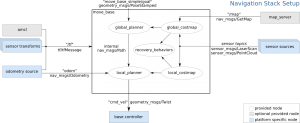Recommended material: SSH essentials, ROS on multiple machines, ROS Network Setup , Turtlebot setup
Robots generally require lots of networking, due to the constraints of portability, limited computational power, and robot’s usual multi-part composition. This unfortunately meant that programmers were often required to deal with the fun, easy networking problems of networking.
Thankfully, ROS, with its approach of treating everything as a node and its publisher-subscriber model, removes much of the difficulty that comes with networking – in fact, there is hardly a difference between the node on the computer and the node elsewhere in the network.
As with anything in life, there are some caveats. One, you still have to deal with the underlying networking for Linux/OSes. Second, you do need to setup the environment so that everything may recognize one another.
First, please refer to the ROS on multiple machines tutorial, referenced above. Below are basic information/definition about networking below.
I.P. Address (Internet protocol address) – the number that is used for the network devices (routers, internet service providers) to identify you. There are several different IPs – there is one specific to your machine, generated by your machine (127.0.0.1), the local address generated by the router (or school network in our case, and the address used over the internet (e.g. the address I provided for the virtual Linux instance).
DNS (Domain Name Resolution) – a server that translates an IP address to a rememberable name (google.com); if you look at the ROS network setup, there is a local alternative to this by changing the configuration file.
Static/Dynamic address – Once declared static, IP addresses are each dedicated to a machine, not changing once it comes on and off. For dynamic addressing, each machine in the network is given an available address when they log in to the network, using method called DHCP. Typically, most large networks and routers do dynamic addressing, and static address is used generally for small, private networks or tools that require constant address (e.g. websites).
Port – Necessary appendage to IP addresses for there to be a connection; it generally indicates the type of the connection – 80 is used for HTTP, 25 for SMTP (email), and 22 for SSH. Beyond these commonly used ports, you can use the ports for your own communications. Network admins or routers with strict security policy tend to block all the ports that are not used, as restricting ports restricts malicious people accessing the network in via brute force.
Firewall –As mentioned above, routers can block ports and specific IP addresses from being used for outside communications. Some ways to get around this is to use something called VPN (Virtual Private Network) and pass that data you were share through one port through a port already open (Port 80 of HTTP generally).
MAC Address – Hardware-specific (to network card) addresses used for – you guessed it – hardware identification. Note that MAC addresses are only known to each once they are connected; you can’t connect to another computer using MAC Address.
Now, back to the page. To summarize the page, let me emphasize that once you set up the ROS_MASTER_URI environmental variable (variables that are stored and used in the shell like bash) and the connections, the ROS nodes on separate computers can communicate immediately using ROS methods like topics and services.
Once those things are done, you should be set – that is, of course, if you were able to setup everything without trouble.
If you are indeed in trouble, refer to the tools below to troubleshoot the issue.
ssh – as always, you could use it to access the other computer through a network. You can also scp to copy files through ssh.
ifconfig – reveals network information, like MAC address, device name (wlan0, etc), and IP address
ping – checks if the computer is connected to a specific IP address. To test connection to local computers, use ping <local_address>. To test internet connection, use ping 8.8.8.8 – which is one of the Google’s addresses. You can also verify things like network latency, if there is any network “packets” being dropped (not getting response).
tracert – Use it to check what devices are between your network connection.
Router address – The router configurations are accessible by typing its address into a browser, and are generally addresses with two one’s at the end of the addresses of the computer (i.e. 192.168.1.103 computer address generally translates to 192.168.1.1 for routers).
nmap / ping broadcasting – To find the IP address of the devices of same network, broadcasting a message in the network and waiting for a response is one of the ways to find it.
